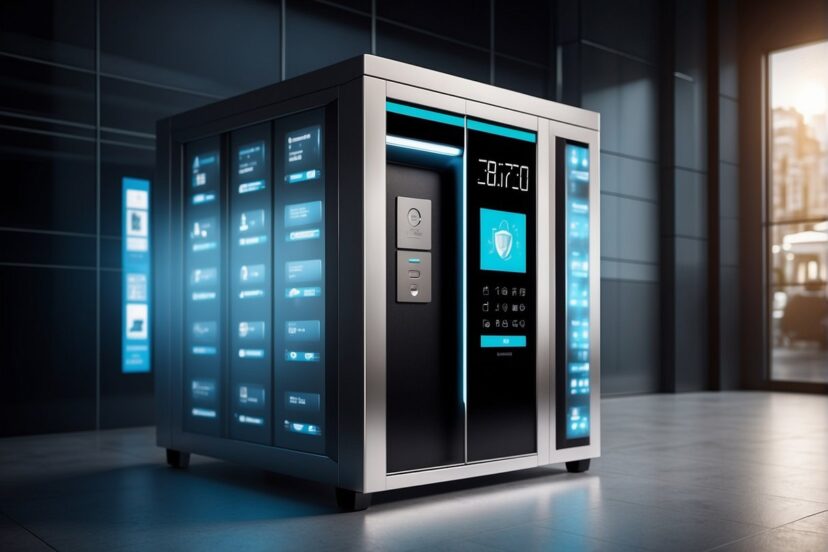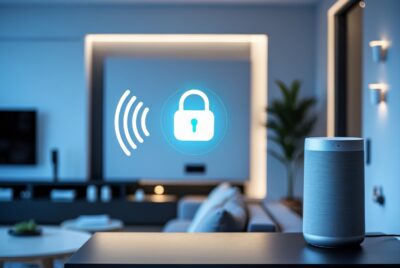Smart Locker Systems: Secure Storage Solutions
*We may earn a commission for purchases made using our links. Please see our disclosure to learn more.
Smart Locker Systems: Transforming Secure Storage Solutions
As advancements in technology reshape our daily interactions, a smart locker emerges as a notable innovation designed to streamline the way I store and secure items. The incorporation of Internet of Things (IoT) technology allows these lockers to connect to the internet, enabling features such as remote access, real-time status updates, and enhanced security. This technology is not confined to personal use; it’s highly adaptable across various environments, from safeguarding personal goods in public spaces to managing assets in factories or warehouses.

I appreciate the utility of smart lockers as they address a myriad of logistical challenges. For instance, in residential and commercial buildings, smart lockers provide a secure and convenient solution for package deliveries, mitigating the risk of theft and misplacement. The United States Postal Service (USPS), recognizing the potential of this technology, has begun installing smart lockers in post office locations to offer a reliable package delivery and return system. These innovations underscore the trend toward integrating smart technology into the fabric of everyday life.
Driving the functionality of smart lockers is sophisticated software that enables them to be more than mere storage boxes. With the ability to control access through a smartphone or other connected devices, they offer customizable interactions based on the needs of the user. Whether I’m using a smart locker for personal storage in a high-traffic area or monitoring valuable equipment in a warehouse setting, the underlying software is key to delivering a flexible and secure user experience.
Understanding Smart Locker Systems

Smart locker systems are transforming the way we secure and manage assets. I will explain how they work, the technology they incorporate, and the substantial benefits they offer over traditional storage solutions.
Fundamentals of Smart Lockers
Smart lockers are at the forefront of locker system innovation. They offer not just secure storage space but also integrate locker management software and smart locker technology. Essentially, a smart locker system consists of compartments that can be accessed via electronic means, replacing conventional locks with advanced locking mechanisms. Users typically interact with these lockers through a central console or mobile application, allowing for flexible and 24/7 access.
Key Components:
- Locking Mechanism: Electronic or biometric systems
- Software: Locker management and asset tracking applications
- Access Control: Methods include PIN codes, RFID cards, or biometric scans
Technological Advancements
The evolution of smart locker solutions is closely linked with the Internet of Things (IoT). These lockers are equipped with sensors and connected through Wi-Fi, enabling remote management and real-time asset tracking. This connectivity ensures that users are always informed about the availability and status of their contents.
Important Technologies:
- IoT Integration: Connects lockers to the internet for instant monitoring
- Asset Management: Software for inventory control and usage tracking
- Electronic Locker Systems: Provide a user-friendly interface and secure access mechanisms
Operational Benefits of a Smart Locker
Implementing a smart locker system comes with several operational benefits. They can dramatically reduce costs associated with locker management and offer more flexibility in how storage space is allocated. My comprehensive research indicates that smart lockers can automate workflows, resulting in up to 94% time savings for managing lockers. They provide a more secure environment for storing valuable assets like laptops, tablets, and mobile phones and support a variety of use cases including lending and IT requests.
Advantages Include:
- Cost Reductions: Lower capital and operational expenses
- Enhanced Security: Better protection of assets
- Efficiency: Automated management conserves time and resources
By harnessing smart locker systems, organizations can achieve a level of efficiency and security that far surpasses traditional lockers. These systems are more than just lockers; they serve as sophisticated tools for modern asset management.
Smart Locker Applications

Smart locker systems are transforming how businesses, educational institutions, and retail ecosystems manage storage and delivery. My focus is to illustrate their versatility, security, and efficiency in various applications.
Industry-Specific Uses
Smart lockers find their relevance significantly within industry-specific settings. Retail stores use them for click-and-collect lockers, ensuring customers can securely pick up their online orders. In the corporate world, they optimize mailbox systems, granting employees access to mail and packages without administrative intervention. Universities and libraries deploy smart locker technology for safe book loans and returns, evolving the check-out process.
- Smart Locker Applications in Various Industries:
- Retail Stores: Click-and-collect lockers for online order pickups.
- Universities: To facilitate book loans and return processes.
- Corporate Offices: Secure mailbox systems for confidential documents.
These lockers are equipped with real-time tracking, which allows for efficient asset collection and streamlines reverse logistics. It’s about harnessing technology to tailor services specific to the needs of an industry.
Delivery and Collection Efficiency
In the domain of package delivery, smart lockers are a game-changer. They serve as parcel lockers where delivery companies can securely leave packages for recipients. This method significantly reduces wait times and missed deliveries. They also assist in reverse logistics, providing an easy system for customers to return products without requiring direct human interaction every time.
- Efficiency Metrics:
- Reduces package delivery wait times.
- Minimizes missed deliveries and streamlines the return process.
This efficient system supports a seamless delivery and collection service for residential complexes and commercial establishments alike.
Secure and Personal Storage Solutions
The implementation of smart lockers in workplaces offers enhanced secure storage for personal belongings while allowing staff lockers to be managed remotely. These employee lockers are optimal for safeguarding personal storage with the sophistication of real-time tracking.
- Secure Storage Features:
- Staff Lockers: Automated management with remote access.
- Employee Lockers: Protecting personal belongings with advanced security.
Whether it’s for a temporary visitor or full-time staff, smart locker systems provide a dependable method to store items of varying sensitivities across various settings. My insight into their application demonstrates that smart lockers are indeed a revolutionary step in melding automation with everyday logistical challenges.
End-User Interaction and Accessibility

Smart Lockers have redefined package management and personal storage by providing a seamless user experience combined with reliable accessibility. I’m going to discuss how these systems facilitate user interaction and offer 24/7 availability.
User-Friendly Experience
My interactions with Smart Locker systems have consistently been user-friendly. Typically, a Smart Locker application on my smartphone allows me to access the services. Here’s a step-by-step on how easy it is:
- Receive QR Code: After a parcel is delivered, I receive a QR code via email or the locker app.
- Scan to Retrieve: I scan the QR code at the locker station, which prompts the assigned locker to open automatically.
- Contactless Access: This process ensures a contactless experience — paramount for both convenience and hygiene.
The user interface is intuitive, which minimizes the learning curve and keeps transaction costs low. Real-time tracking provides me with asset tracking capabilities, so I always know the status of my deliveries or stored items.
24/7 Availability and Monitored Access
One of the core advantages I appreciate is that I can access Smart Lockers anytime — they offer 24/7 access. Whether I’m picking up a package early in the morning or late at night, the lockers are available:
- Around-the-Clock Use: No more rushing to pick up packages during working hours.
- Security Measures: Lockers are often equipped with high-grade materials and monitored access, ensuring the safety of my stored items.
Moreover, automated notifications keep me informed about my locker interactions, giving me peace of mind that my belongings are secure and retrievable at my convenience. The integration of real-time tracking systems logs and monitors any access, providing reliable security and user access management.
Management and Integration of a Smart Locker

Integrating smart locker systems is crucial in modern asset management to ensure efficiency, transparency, and security. Proper management software is the cornerstone of these systems, facilitating reduced costs and optimized operations.
Locker Management Software
My role in implementing locker management software is integral to the operation of smart lockers. This software provides a clear dashboard that offers real-time data on locker availability, usage patterns, and maintenance needs. By automating tasks that were once manual processes, such as asset tracking and user notifications, these systems significantly reduce costs and increase operational efficiency. They also offer the flexibility to adapt to various business environments.
Implementation and Customization of a Smart Locker
In my experience, successful implementation and customization of smart locker systems often hinges on their ability to integrate with existing business systems. This may include linking with spreadsheets or company databases for streamlined asset management. Locker experts frequently emphasize the importance of customizable solutions which can incorporate additional business software to innovate and expand functionalities, such as using hot lockers for high-demand items.
Security and Accountability
A key feature of my smart locker solutions is enhancing security and accountability. The locking mechanism ensures secure storage, while the management system allows for detailed asset tracking, guarding against unauthorized access and keeping detailed records for each transaction. Enhanced transparency is ensured through audit trails and reporting features, fostering a high degree of accountability and reducing the risk of asset loss.
Frequently Asked Questions
In this section, I’ll provide clear and concise answers to some of the most common queries regarding smart locker systems.
1. How do smart lockers enhance security in office environments?
Smart lockers in office environments use advanced security protocols including electronic access controls that can integrate with existing employee ID systems. This reduces the risk of theft or tampering compared to traditional lockers.
2. What are the benefits of installing smart lockers at home?
Installing smart lockers at home offers secure package delivery, minimizing the risk of theft. They can also control access to goods and oversee personal item exchanges in a home environment.
3. How does smart locker technology integrate with package delivery services like USPS?
Smart locker technology integrates with package delivery services like USPS, using electronic notifications and secure one-time access codes. Users receive alerts when their smart locker receives a package, guaranteeing a safe and efficient collection process.
4. What features should one look for in smart locker software?
When evaluating smart locker software, look for features such as real-time availability tracking, remote locker management, user authentication mechanisms, and detailed usage reporting.
5. How do smart lockers handle package delivery and collection?
Smart lockers handle package delivery by accepting items from couriers through secure compartments. For collection, recipients use a unique access code or an authenticated mobile app to open their designated locker and retrieve their package.




